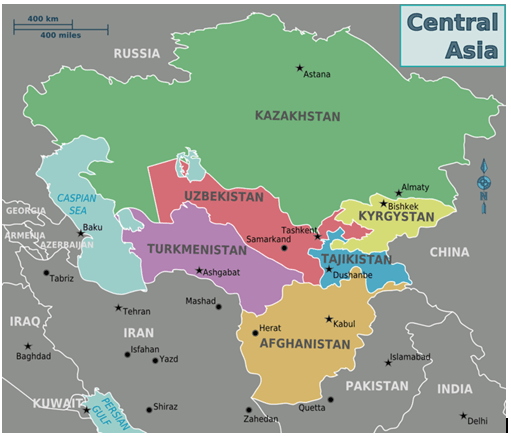Editorials/Opinions Analysis For UPSC 29 January 2022
Contents:
- At the Centre
- Flying Home
At the Centre
Context:
The India-Central Asia virtual summit was recently concluded. The Prime Minister of India hosted the first India-Central Asia Summit virtually on 27 January 2022 which was attended by the Presidents of the five Central Asian Republics (CARs).
Relevance:
GS II: Groupings & Agreements Involving India and/or Affecting India’s Interests, Global Groupings, India and its Neighbourhood
Dimensions of the Article:
- India-Central Asian Summit
- What are the Challenges?
- Dominant players in Central Asia
- Way Forward
India-Central Asian Summit:
- A joint statement issued at the end of India-Central Asian summit noted-
- Ties between India and the region have been historically close, with “civilisational, cultural, trade and people-to-people linkages”, but the lack of access to land routes, and the situation in Afghanistan are among the biggest challenges.
- The summit came after the meeting of NSAs in Delhi.
- The Joint summit highlighted the following aspects:
- To address every issue related to the connectivity between India and Central Asia.
- Setting up of joint working groups, on Afghanistan and Chabahar
- Improving educational and cultural opportunities

What are the Challenges?
- With reference to the energy exports from Kazakhstan to India, it is around $2 billion which is very less compared to the China’s CAR trade figures that exceeded $41 billion and they could double by 2030. Additionally China’s has invested billions of dollars in the Belt and Road Initiative.
- Chabahar port: With Pakistan denying India transit trade, India’s other option is to smoothen the route through Iran’s Chabahar port.
- Issues:
- This requires huge investment in rail and road routes to Iran’s northern boundaries.
- India is however hesitant to do it in the face of U.S. sanctions.
- Issues:
- Russia-Iran International North-South Transport Corridor: India can alternatively use the Russia-Iran International North-South Transport Corridor via Bandar Abbas port.
- Issues:
- The route is not fully operational.
- The Central Asian Region members namely Uzbekistan and Turkmenistan are not its members
- Issues:
- TAPI gas pipeline: India has also tried operationalize the plans over Turkmenistan-Afghanistan-Pakistan-India(TAPI) Pipeline.
- Issues:
- India’s current tensions with the Pakistan plagued by terrorist incidents
- Afghanistan, the tenuous link between Central Asia and South Asia is stuck in an humanitarian crisis after its takeover by the Taliban. There are worries of terrorism and radicalism spilling over its boundaries.
- Issues:
Dominant players in Central Asia:
- India has increased its attempt to institutionalise exchanges and has focused to improve on trade, investment and development partnerships with the CARs.
- Though the timely effort of India is commendable, it is not the only country strengthening its ties in the region.
- Russia: The role of Russia in the region is more as a strategic player,
- China: China is currently the biggest development and infrastructure partner to the countries.
- The CAR Presidents held a similar virtual summit with Chinese President earlier.
- Pakistan: Pakistan has also increased its hold over the region. It has signed several transit trade agreements, offering trade access to the Indian Ocean at Gwadar and Karachi.
Way Forward:
India should briskly move forward to ensure that it stays in step with the changes and to make certain the future of ties more closely resembles the deep ties of the distant past.
-Source: The Hindu
Flying Home
Context:
The Air India disinvestment process was completed on Thursday. The Airline was taken over by the Government seven decades ago has now been handed over to the Tata group.
Relevance:
GS III: Mobilization of Resources, Government Budgeting
Dimensions of the Article:
- Privatisation of Air India
- The Challenge before the Tatas
- Government’s disinvestment proceeds
- Way Forward
Privatisation of Air India:
- The Tata Group was the highest bidder for the airline last here has now gained complete ownership (100% stake) in Air India, Air India Express, and a 50 per cent stake in the ground handling firm AI-SATS.
- This sale marks the first major outright privatisation of a public sector entity in recent years.
- Though there has been criticism of the pace and manner of the government’s privatisation programme, the symbolism of this sale is hard to ignore.
The Challenge before the Tatas:
- Managing the Debt ridden Airline can be a challenging task.
- Apart from dealing with the issues from the past, the organization has to deal with the others issue from an ageing fleet to human resources management at the time when the aviation industry is grappling with the fallout from the pandemic.
- The group should also deal with other competing airlines namely Vistara and AirAsia India.
- According to the bidding conditions, the Tatas will have to retain all employees for a one-year period.
- It is possible that the Tatas will at some point consider integrating their aviation ventures under a single entity.
Government’s disinvestment proceeds:
- This is seen as a milestone in the efforts of the government towards Disinvestment.
- However, this does little towards increasing the government’s disinvestment proceeds as a major part of the money will be retained with the group in the form of debt.
- Data from DIPAM shows that the government’s proceeds from disinvestment remain well short of the target.
- The privatisation of LIC IPO, Bharat Petroleum Corporation Limited (BPCL) as well as that of the public sector banks is also expected to spill over into the next year.
Way Forward:
- Though there has been criticism of the pace and manner of the government’s privatisation programme, this is a significant step towards government’s efforts for Privatisation.
-Source: The Indian Express




